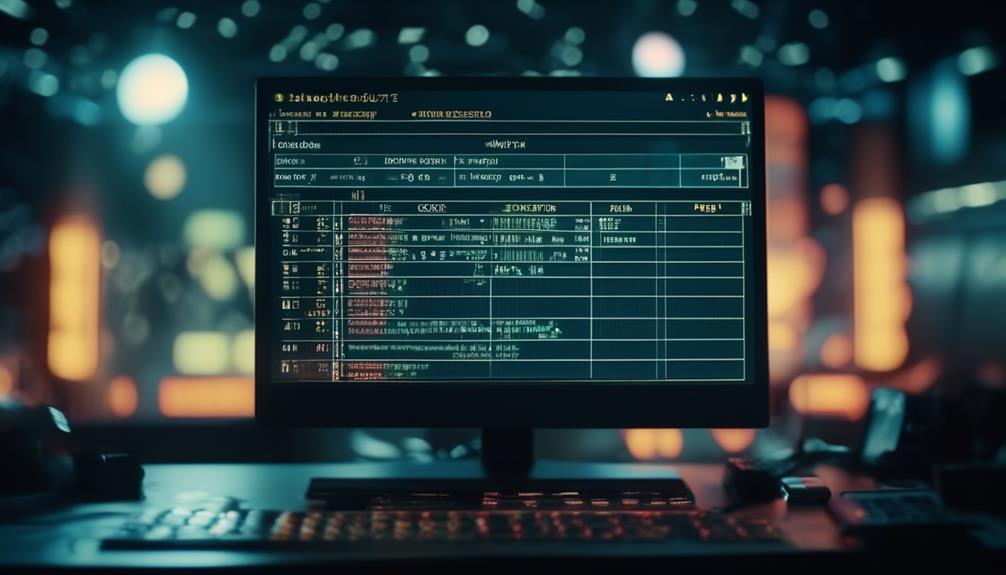Imagine you’re a pilot navigating through a dense fog, relying solely on your instruments to guide you. One wrong move could have disastrous consequences. In a similar way, handling image data entry errors requires precision and attention to detail. Every keystroke matters, as a single mistake can lead to misinformation and costly consequences. So, how do you ensure accuracy and minimize errors in image data entry? In this discussion, we will explore effective strategies and tools to help you navigate this challenging task, ensuring that your data is reliable and error-free. Stay tuned to discover the secrets of smooth data entry and the importance of error handling.
Open Data Entry Software
To improve the accuracy and efficiency of image data entry, consider utilizing open data entry software. Open data entry software offers various features that can help with data validation and error prevention. One key feature is automated data validation, which checks the entered data against pre-defined rules. This ensures that the data entered is accurate and meets the required standards. By flagging any discrepancies or errors in real-time, open data entry software helps prevent mistakes from going unnoticed and ensures data integrity.
Another advantage of open data entry software is its ability to provide error prevention mechanisms. It can offer suggestions or auto-correct options when it detects potential errors, reducing the likelihood of mistakes being made. Additionally, open data entry software often includes built-in error detection algorithms that analyze the data for inconsistencies or missing information. This helps in identifying and rectifying errors before they cause any major issues.
Open data entry software also enables the use of data templates, which provide a structured framework for entering data. This helps streamline the entry process and reduces the chances of errors due to manual input. Furthermore, the software can offer real-time error alerts and notifications, allowing users to address any issues immediately.
Load the Image File
You can begin the image data entry process by loading the image file into the open data entry software. This step is crucial as it allows you to access the image and input the relevant data accurately. When loading the image file, consider the following data entry software features and image file format compatibility:
- Ease of Use: Look for software that offers a user-friendly interface, making it effortless to locate and load image files. This ensures a smooth and efficient data entry process.
- Multiple File Formats: Ensure that the data entry software supports a wide range of image file formats such as JPEG, PNG, TIFF, and GIF. This compatibility allows you to work with various types of images without any compatibility issues.
- Preview Option: Opt for software that provides a preview option for the image files. This feature allows you to view the image before entering the data, ensuring accuracy and minimizing errors.
Review the Entered Data
Once the image data has been entered, it is essential to carefully review the entered data for accuracy and completeness. Ensuring data entry accuracy is crucial to maintain the integrity of the information and prevent errors from propagating throughout the system. To achieve this, utilizing data validation techniques can be highly beneficial.
Data validation techniques involve verifying the entered data against predefined rules or criteria. This process helps identify any inconsistencies, errors, or missing information. One commonly used technique is the use of validation checks, such as range checks, format checks, and duplicate checks. Range checks ensure that the entered data falls within a specified range, while format checks verify that the data is in the correct format, such as date or email format. Duplicate checks help identify if the data being entered already exists in the system.
Reviewing the entered data should be done meticulously to catch any mistakes or omissions. It is essential to compare the entered data with the original source or reference material to ensure accuracy. Additionally, double-checking calculations, cross-referencing information, and ensuring consistency among related data entries are crucial steps in the review process.
Identify Errors
Now it’s time to identify the errors in your image data entry. There are various techniques you can use to spot these errors, such as comparing data against known standards or using statistical analysis. Additionally, implementing error tracking methods can help you keep track of the errors you find and ensure they are properly addressed. By utilizing these techniques and methods, you can effectively identify and rectify any errors in your image data entry process.
Error Identification Techniques
To effectively identify errors in image data entry, employ techniques that are concise, detail-oriented, and focused on accuracy. Here are some error identification techniques that can help you minimize mistakes and ensure the quality of your data:
- Double-checking: Take the time to review your work thoroughly, comparing it against the original image to spot any inconsistencies or inaccuracies.
- Cross-referencing: Compare the entered data with other reliable sources of information to verify its correctness and detect any discrepancies.
- Error log analysis: Keep a record of all the errors encountered during the data entry process and analyze them to identify patterns or common mistakes that can be prevented in the future.
Error Tracking Methods
One effective method for identifying errors in image data entry is through the use of error tracking methods. These methods involve implementing error prevention techniques and error reporting systems. Error prevention techniques are proactive measures put in place to minimize the occurrence of errors during the data entry process. These techniques can include double-checking entries, using validation rules, and providing clear instructions to data entry personnel. On the other hand, error reporting systems are tools or software that allow for the tracking and reporting of errors as they occur. These systems provide real-time notifications and alerts, allowing for immediate action to rectify any errors. By utilizing error tracking methods, businesses can improve the accuracy and reliability of their image data entry processes.
Correct the Errors
Now that you have identified the errors in the image data entry, it’s time to correct them. There are several techniques you can use to ensure error-free data entry, such as double-checking the entered data against the original image and using data entry verification tools. Additionally, implementing error correction strategies, such as highlighting and correcting the wrong entries, can help you rectify any mistakes and maintain accurate data records.
Error Identification Techniques
Using error identification techniques is essential for correcting image data entry errors. When it comes to identifying and rectifying errors, there are several helpful techniques you can employ:
- Visual Inspection: Take a close look at the image data and compare it with the entered data to spot any discrepancies.
- Automated Error Detection: Utilize specialized software that can automatically identify common errors, such as missing or incorrect fields.
- Data Validation: Implement validation rules to ensure that the entered data meets specific criteria, such as format or range limitations.
Data Entry Verification
To effectively correct image data entry errors, the next step is to focus on the process of data entry verification. Data entry verification plays a crucial role in ensuring data accuracy and preventing errors. It involves reviewing and comparing the entered data against the original source or document to identify and correct any discrepancies or mistakes. This verification process can be done manually by a data entry operator or through automated software tools specifically designed for data validation. By performing data entry verification, organizations can minimize the risk of inaccurate data, improve data quality, and enhance overall efficiency. It is essential to establish clear verification procedures and guidelines, provide proper training to data entry operators, and regularly monitor the verification process to maintain high levels of data entry accuracy and error prevention.
Error Correction Strategies
One effective strategy for correcting image data entry errors is to carefully review the entered data against the original source or document. This allows you to compare the information and identify any discrepancies or mistakes. In addition to this method, there are several other error correction strategies that you can employ:
- Utilize error prevention methods such as double-checking the data entry before finalizing it.
- Use error resolution techniques like cross-referencing the entered data with other relevant sources to ensure accuracy.
- Implement data validation procedures to automatically detect and correct common errors, such as misspellings or incorrect formatting.
Save the Corrected Data
You can save the corrected data by following these steps. After applying the necessary data correction techniques to improve data quality, it is crucial to save the corrected data in a secure and accessible location. First, ensure that you have a backup of the original data before making any corrections. This will allow you to refer back to the original data if needed. Next, create a new file or database to store the corrected data separately from the original file. This will prevent any confusion or mixing up of data. Be sure to use a descriptive and meaningful filename or table name to easily identify the corrected data. Additionally, consider implementing version control to track any changes made to the data or to revert back to a previous version if necessary. Finally, regularly backup the corrected data to avoid any loss of data due to technical issues or accidents. By following these steps, you can ensure that the corrected data is securely saved and easily accessible for future use.
Frequently Asked Questions
Is There Any Specific Open Data Entry Software That Is Recommended for Handling Image Data Entry Errors?
You can consider using open source alternatives for handling image data entry errors. These software have pros and cons, like the ability to use image recognition software for error detection and correction.
What Are Some Common File Formats That Can Be Loaded as Image Files in the Data Entry Software?
You can load various image file formats like JPEG, PNG, GIF, TIFF, and BMP into the data entry software. These are commonly used file formats for image files in data entry.
How Can I Efficiently Review the Entered Data to Identify Any Errors in the Images?
Efficiently review the entered data to identify errors in the images by carefully examining each one. Look for inconsistencies, blurriness, or missing information. Take your time and pay attention to detail to ensure accuracy.
Are There Any Automated Tools or Features in the Data Entry Software That Can Help Identify Errors in the Image Data?
Yes, there are automated tools and features in the data entry software that can help you identify errors in the image data, increasing error detection and correction efficiency.
Can the Data Entry Software Automatically Save the Corrected Data or Do I Need to Manually Save It After Making Corrections?
The data entry software can automatically save the corrected data, so you don’t have to manually save it after making corrections. As for specific open data entry software for handling image data entry errors, recommendations vary depending on your needs.




